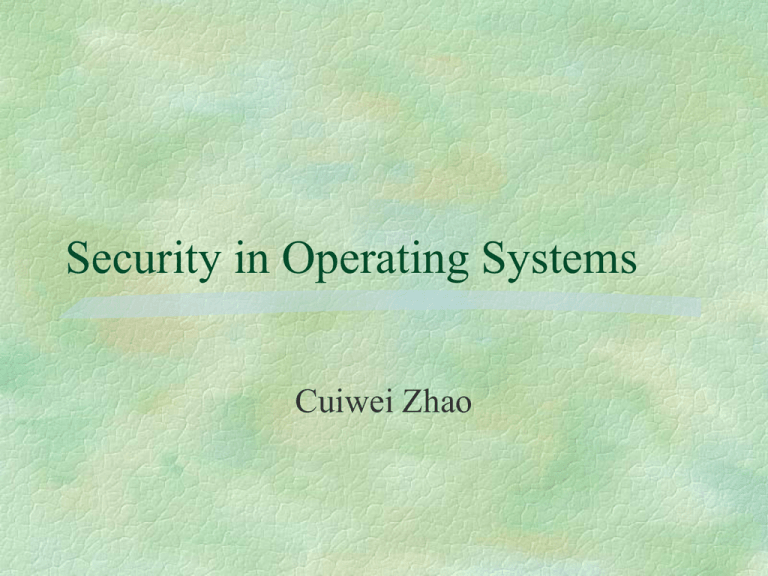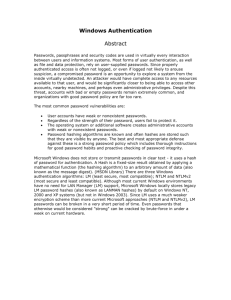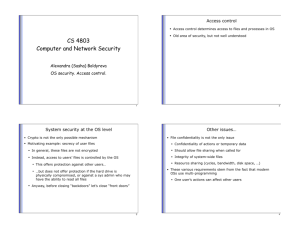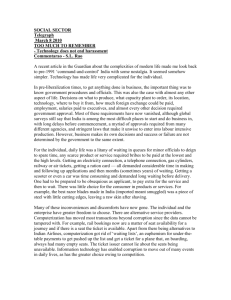Protection in General-Purpose Operating Systems
advertisement

Security in Operating Systems Cuiwei Zhao Security in Operating System Security breaches Security goals Protected objects of the general purpose operating system Protection of objects Beaches Exposure A form of possible loss or harm in a computing system Vulnerability Weakness that might be exploited to cause loss or harm Threats circumstances that have the potential to cause loss or harm Threats Interruption Interception Modification Fabrication Security Goals Confidentiality the assets of a computing system are accessible only by authorized parties. Integrity assets can be modified only by authorized parties or only in authorized ways. Availability assets are accessible to authorized parties. Protection In General-Purpose OS Protected Objects and Methods Protecting Memory and Addressing Protecting Access to General Objects File Protection Mechanisms User Authentication Protected Objects and Methods Protected Objects Security Methods of Operating Systems Protected Objects • Memory • Sharable I/O devices, such as disks • serially reusable I/O devices, such as printers and tape drives • sharable programs and sub-procedures • sharable data Security Methods of Operating Systems Separation: keeping one user’s objects separate from other users’ • • • • Physical Separation Temporal Separation Logical Separation Cryptographic Separation Granularity of Control the larger the level of object controlled, the easier it is to implement access control. Protecting Memory and Addressing Fence Relocation Base/Bounds Registers Tagged Architecture Segmentation Paging Fence A fence is a method to confine users to one side of a boundary. Usually, fence is implemented via a hardware register. Relocation Relocation is the process of taking a program written as if it began at address 0 and changing all addresses to reflect the actual address at which the program is located in memory. Fence register can be used within relocation process. To each program address, the contents of the fence register are added. This both relocates the address and guarantees that no one can access a location lower than a fence address. Base/Bounds Registers In a multiuser, multiprogramming environment, fence register is variable. In this case fence register is called base register. Fence registers only provide a lower bound (a starting address), but not an upper one. A second register, called a bounds register can be used to provide a upper bound. In this way, a program’s addresses are neatly confined to the space between the base and the bounds registers. This technique protects a program’s addresses from modification by another user. Tagged Architecture The disadvantage of Base/Bounds technique Tagged Architecture Every word of machine memory has one or more extra bits to identify the access rights to that word. This technique is not wide spread because of the market consideration (compatible). Segmentation Segmentation divides a program into separate pieces. Each piece has a logical unity, a relationship among all of its code or data value. Segmentation was developed as a feasible means to have the effect of an unbounded number of base/bounds registers: a program could be divided into many pieces having different access rights. The operating system must maintain a table of segment names and their true addresses in memory. The program address is in the form <name, offset>. OS can retrieve the real address via looking for the table then making a simple calculation: address of the name + offset Paging An alternative to segmentation is paging. The program is divided into equal-sized pieces called pages, and memory is divided into the same sized units, called page frames. Each address is represented in a form <page, offset>. Operating system maintains a table of user page numbers and their true addresses in memory. The page portion of every <page, offset> reference is converted to a page frame address by a table lookup; the offset portion is added to the page frame address to produce the real memory address of the object referred to as <page, offset>. Protecting Access to General Objects Directory Access Control List General Objects • • • • • • • • • • Memory a file or data set on an auxiliary storage device an executing program in memory a directory of files a hardware device a data structure, such as a stack. A table of the operating system instructions, especially privileged instructions passwords the protection mechanism itself Directory This technique works like a file directory. Imagine the set of objects to be files and the set of subjects to be users of a computing system. Every file has a unique owner who possesses “control” access rights, including the right to declare who has what access and to revoke access to any person at any time. Each user has a file directory, which lists all the files to which that user has access. OS maintains all directories. Each user has a list (directory) that contains all the objects that user is allowed to access. Access Control List Each object has an access control list. This list shows all subjects who should have access to the object and what the access is. This technique is widely used in Distributed File Systems. File Protection Mechanisms Basic Forms of Protection Single Permissions Basic Forms of Protection All-None Protection The principal protection was trust, combined with ignorance. Group Protection Users in the same group have the same right for objects. Single Permissions Password or other token assign a password to a file Temporary Acquired Permission Unix set userid permission. If this protection is set for a file to be executed, the protection level is that of the file’s owner, not the executor. User Authentication Use of Passwords Attacks on Passwords Password Selection Criteria The Authentication Process Flaws in the Authentication Process Authentication Other Than Passwords Use of Passwords Passwords are mutually agreed-upon code words, assumed to be known only to the user and the system. The use of of passwords is fairly straightforward. A user enters some piece of identification, such as a name or an assigned user ID, if the identification matches that on file for the user, the user is authenticated to the system. If the identification match fails, the user is rejected by the system. Attacks on Passwords Try all possible passwords exhaustive or brute force attack Try many probable passwords Users do not likely select a password uncommon, hard to spell or pronounce, very long Try passwords likely for the user Password generally is meaningful to the user Attacks on Passwords (cont’) Search for the system list of passwords Finding a plain text system password list Ask the user Get the password directly from the user. Password Selection Criteria Use characters other than just A-Z Choose long passwords Avoid actual names or words Choose an unlikely password Change the password regularly Don’t write it down Don’t tell anyone else The Authentication Process Intentionally slow This makes exhaustive attack infeasible identify intruder from the normal user some who continuously fails to login may not be an authorized user. System disconnect a user after three to five failed logins Reference D. Denning, P. Denning, Certification of Programs for Secure Information Flow, CommACM, V20 N7, Jul 1977, pp. 504-513 J. Linn, Practical Authentication for Distributed Computing, Proc IEEE symp Security & Privacy, IEEE Comp Soc Press 1990, pp. 31-40 C. P. Pfleeger, Security in Computing, Prentice Hall, NJ, 1996




